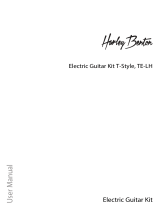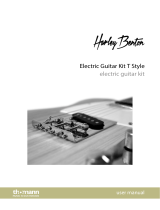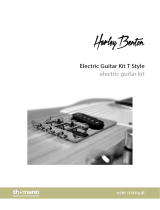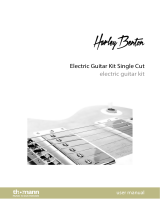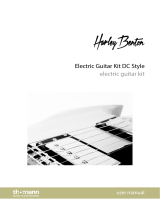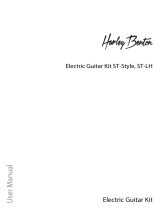Page is loading ...

Bass Guitar Kit P-Style
bass electric guitar kit
user manual

Musikhaus Thomann
Thomann GmbH
Hans-Thomann-Strasse 1
96138 Burgebrach
Germany
Telephone: +49 (0) 9546 9223-0
E-mail: [email protected]
Internet: www.thomann.de
05.01.2021, ID: 194896

Table of contents
1 Safety instructions................................................................................................................. 4
2 Scope of delivery..................................................................................................................... 5
3 Assembly instructions.......................................................................................................... 6
3.1 Cut the headstock to size............................................................................................. 6
3.2 Painting the body and neck........................................................................................ 7
3.3 Mounting the tuners...................................................................................................... 8
3.4 Mounting the string retainer....................................................................................... 9
3.5 Mounting the guitar neck............................................................................................ 9
3.6 Wiring the potentiometers, pickups and switches........................................... 11
3.7 Mounting the pickguard............................................................................................ 13
3.8 Mounting the bridge................................................................................................... 14
3.9 Mounting the strap buttons..................................................................................... 15
3.10 Strings, neck relief, string height and pickups................................................. 16
4 Protecting the environment........................................................................................... 20
Table of contents
Bass Guitar Kit P-Style
3

1 Safety instructions
DANGER!
Danger for children
Ensure that plastic bags, packaging, etc. are properly disposed of and
are not in the reach of babies and young children. Choking hazard!
Ensure that children do not detach any small parts (e.g. knobs or the
like) from the product. They could swallow the pieces and choke!
Never let children play unattended with the product.
CAUTION!
Danger of cuts on the hands
While assembling and joining individual parts together with screws pay
attention to sharp edges on tools, screws and components.
Safety instructions
bass electric guitar kit
4

2 Scope of delivery
Thank you for buying this guitar kit. All the wood, hardware and electrical compo‐
nents of the guitar are contained in this package.
The picture below shows the individual items included in the delivery.
The assembly is described in detail in the following sections.
Scope of delivery
Bass Guitar Kit P-Style
5

3 Assembly instructions
Provide the following tools and materials for the assembly of the guitar:
n Phillips screwdriver
n Rubber mallet
n Ring spanner
n Pliers
n Paint and accessories
n Needle le
n Sandpaper
It is important to paint the body and neck before assembly.
Always wear a dust mask when applying spray paint.
3.1 Cut the headstock to size
Cut the headstock to your desired shape using a suitable saw. Ensure you leave su‐
cient space between the cutting edge and the holes for the tuners to maintain sta‐
bility. The tuners' retaining rings should be used as a reference here.
After cutting, smooth the cutting edge with sandpaper or a suitable le.
Useful tools and materials
Assembly instructions
bass electric guitar kit
6

3.2 Painting the body and neck
The solid wood body of the guitar is sealed and prepared for various types of lacquer
coating. A wide variety of nishes can be procured from DIY, timber and automotive
outlets in aerosol cans making nishing straightforward without requiring specialist
skills.
The rst step is to check the t of the body to the neck joint. These components are
machined from high-grade tonewoods to ensure optimum alignment. Since wood is
a natural material, however, its shape changes slightly over time. If the t is too tight,
you can adjust it using a sharp chisel or sandpaper. Please remember that the addi‐
tional lacquer coat will make the neck t a little more tightly into the cutout.
Before coating the body, ensure that all surfaces are clean and free of dirt and dust.
Carry out all painting operations in a well-ventilated, dust-free environment. Consid‐
ered and careful working are key factors for a qualitatively satisfactory result. We
explicitly recommend that you rst try out the colour and technique on another
piece of wood.
Paint the body edges rst and let them dry. If the edges are dry, go on with front and
back side. By layered, successive application you can achieve a uniform coating struc‐
ture. If you notice surface irregularities, wait until the paint has dried completely and
correct them with ne sandpaper (e.g. 800+) before proceeding to paint. For full cov‐
erage apply three or more layers.
Insert a wire or hook into the cutout for the guitar neck and hang the painted guitar
body to dry in a dry, dust-free area away from direct sunlight.
Wait another two to three days until the paint is fully cured. Polish or burnish the
body until it meets your expectations. Take care not to bu too vigorously as this
may remove the nish.
The neck of the guitar is sealed at the factory with a thin layer of matt lacquer and is
already ready to use. However, if you would still like to treat the neck with paint or
clear lacquer, follow the instructions below.
Carefully mask o the ngerboard and all frets before you start painting. Make sure
that all surfaces are free of dust and dirt. Carry out all painting operations in a well-
ventilated, dust-free environment.
Use a clear or lightly coloured wood lacquer of high quality for the neck. Start on the
front and the edges of the headstock. Apply a thin layer evenly, allow it to dry and
repeat this two or three times. If you notice surface irregularities, wait until the paint
has dried completely and correct them with ne sandpaper (e.g. 800+) before pro‐
ceeding to paint.
Once the headstock has dried, place the neck on the ngerboard and paint the back
of the neck as described.
Wait another two to three days until the paint is fully cured. Polish or burnish the
neck until it meets your expectations. Take care not to bu too vigorously as this may
remove the nish.
Painting the body
Neck nish
Assembly instructions
Bass Guitar Kit P-Style
7

3.3 Mounting the tuners
From the front side of the headstock, insert the four sleeves for the tuners into the
holes provided.
From the rear side of the headstock, insert the tuners into the holes provided. Align
the tuners so that the tuning pins are vertical to the upper edge of the headstock.
As illustrated, fasten the tuners in this position with the screws provided.
Assembly instructions
bass electric guitar kit
8

3.4 Mounting the string retainer
Screw the string retainer to the front of the headstock in the holes provided next to
the tuners.
Ensure the string retainer can still move freely. It will be secured by the tension of the
strings.
3.5 Mounting the guitar neck
Place the body on a suitable working surface. Use a soft pad in order to avoid
damage to the surface. Insert the neck into the neck cutout. If necessary, use a sharp
chisel or sandpaper to adjust it. Be very careful when removing material. The neck
should be rmly seated and under no circumstances should there be too much play
in the cutout!
Assembly instructions
Bass Guitar Kit P-Style
9

Turn the bass guitar over and position the neck plate over the four screw holes at the
rear of the body, then screw the four wood screws provided through the neck plate,
body and pilot holes in the neck until everything ts tightly.
Assembly instructions
bass electric guitar kit
10

3.6 Wiring the potentiometers, pickups and switches
The pickups, potentiometers and jack socket are wired using connectors.
Push a spring onto each of the screws on the pickups.
Screw the pickups into the recess in the guitar body using the supplied screws.
Assembly instructions
Bass Guitar Kit P-Style
11

Run the cable for earthing the strings (stripped, without connectors) through the
channel in the recess for the potentiometers and into the hole on the front.
Pull the cable out of the hole far enough to ensure sucient contact with the met‐
allic surface when the bridge is installed. Earthing the strings reduces noise (hum‐
ming).
Assembly instructions
bass electric guitar kit
12

Connect the connector to the connector for the potentiometers and output jack
which is mounted on the pickguard.
3.7 Mounting the pickguard
First, adjust the width of the recess for the guitar neck on the pickguard with a
needle le and/or sandpaper. Then position the pickguard over the front of the body
so that the pickups and all the wires are seated in the correct recesses. Screw the
pickguard onto the body using the screws provided as shown in the picture below.
Assembly instructions
Bass Guitar Kit P-Style
13

3.8 Mounting the bridge
Place the body on a suitable working surface. Use a soft pad in order to avoid
damage to the surface.
Ensure the bridge is aligned with the pre-drilled screw holes. Attach the bridge using
the supplied screws.
Assembly instructions
bass electric guitar kit
14

3.9 Mounting the strap buttons
Screw the strap buttons into the pre-drilled holes in the body as shown.
Assembly instructions
Bass Guitar Kit P-Style
15

3.10 Strings, neck relief, string height and pickups
The strings are threaded from the bridge towards the neck over the corresponding
saddle. Wrap the string end around the tuner several times and pull each string
hand-tight at rst. Be sure that each string is in the correct position on the saddle and
in the correct string retainer.
Then tune each string in turn to the correct pitch. You can using a tuner or a pitch
pipe as a reference. Please note that the string tension will still drift and the guitar
will need to be retuned a few times before the strings are played in.
Stringing the guitar
Assembly instructions
bass electric guitar kit
16

The neck is equipped with a steel truss rod that can be used to adjust the relief to
your preferences.
After tuning the strings, check the relief by pressing on the low E string at the rst
and twelfth fret. The closer the string is to the ngerboard at the sixth fret, the more
noise (buzz) will be audible when the guitar is played.
Adjust the neck relief using an appropriate Allen key as follows:
n Turn the truss bar clockwise to increase tension. The neck will become straighter,
even convex in extreme cases. The string will be closer to the ngerboard, is
easier to fret, but will buzz more during playing.
n Turn the truss bar counterclockwise to decrease tension. The neck will respond
more to the string tension and become correspondingly more concave. The
string will be farther from the ngerboard, be somewhat harder to fret, but will
cause less or no noise during playing.
Adjust the truss bar only by about a quarter turn per setting, then retune all the
strings to the correct pitch and check the neck relief again after a short time. Repeat
this process until the desired neck relief is reached.
Once the neck has the desired relief, you can use the screws for each saddle to adjust
the string position to suit your taste. Here, too, the lower the strings, the easier they
are to fret, but they will buzz more easily when the guitar is played.
Adjusting the neck relief
Adjusting the position of the strings
Assembly instructions
Bass Guitar Kit P-Style
17

After adjusting string position, you can check the octaves of the guitar and readjust if
necessary. Tune all the strings to the correct pitch, gently touch the rst string right
above the twelfth fret and then pick the string. The harmonic you hear (at the 12th
fret) must be the same pitch as the picked string at the 12th fret). If the pitch of the
two notes diers, adjust the saddle for this string back (tone too high) or forth (tone
too low) on the bridge. Listen carefully and adjust gently until the two notes match.
Alternatively, you can also adjust the octaves with a tuner. In this case, the pitch of
the tone at the 12th fret must be the same as the unfretted string, but one octave
higher.
Assembly instructions
bass electric guitar kit
18

The pickups should be set so that all the strings sound equally loud when played.
Adjust the height of the pickups by using the lateral adjustment screws and listening
to the sound. The minimum distance between each string and its pickup is two milli‐
metres. The greater the distance between the string and pickup, the quieter the
string will sound.
Adjusting the pickups
Assembly instructions
Bass Guitar Kit P-Style
19

4 Protecting the environment
For the transport and protective packaging, environmentally friendly materials have
been chosen that can be supplied to normal recycling.
Ensure that plastic bags, packaging, etc. are properly disposed of.
Do not just dispose of these materials with your normal household waste, but make
sure that they are collected for recycling. Please follow the notes and markings on
the packaging.
This product is subject to the European Waste Electrical and Electronic Equipment
Directive (WEEE) in its currently valid version. Do not dispose with your normal
household waste.
Dispose of this device through an approved waste disposal rm or through your local
waste facility. When discarding the device, comply with the rules and regulations
that apply in your country. If in doubt, consult your local waste disposal facility.
Disposal of the packaging material
Disposal of your old device
Protecting the environment
bass electric guitar kit
20
/
